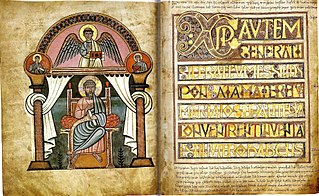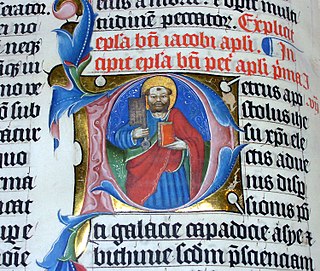
The Book of Cerne is an early ninth-century Insular or Anglo-Saxon Latin personal prayer book with Old English components. It belongs to a group of four such early prayer books, the others being the Royal Prayerbook, the Harleian prayerbook, and the Book of Nunnaminster. It is now commonly believed to have been produced sometime between ca. 820 and 840 AD in the Southumbrian/Mercian region of England. The original book contains a collection of several different texts, including New Testament Gospel excerpts, a selection of prayers and hymns with a version of the Lorica of Laidcenn, an abbreviated or Breviate Psalter, and a text of the Harrowing of Hell liturgical drama, which were combined together to provide a source used for private devotion and contemplation. Based on stylistic and palaeographical features, the Book of Cerne has been included within the Canterbury or Tiberius group of manuscripts that were manufactured in southern England in the 8th and 9th centuries AD associated with the Mercian hegemony in Anglo-Saxon England. This Anglo-Saxon manuscript is considered to be the most sophisticated and elaborate of this group. The Book of Cerne exhibits various Irish/Celtic, Anglo-Saxon, Continental, and Mediterranean influences in its texts, ornamentation, and embellishment.
The Old English Bible translations are the partial translations of the Bible prepared in medieval England into the Old English language. The translations are from Latin texts, not the original languages.

Anna was king of East Anglia from the early 640s until his death.

Deusdedit was a medieval Archbishop of Canterbury, the first native-born holder of the see of Canterbury. By birth an Anglo-Saxon, he became archbishop in 655 and held the office for more than nine years until his death, probably from plague. Deusdedit's successor as archbishop was one of his priests at Canterbury. There is some controversy over the exact date of Deusdedit's death, owing to discrepancies in the medieval written work that records his life. Little is known about his episcopate, but he was considered to be a saint after his demise. A saint's life was written after his relics were moved from their original burial place in 1091.

The Echternach Gospels were produced, presumably, at Lindisfarne Abbey in Northumbria around the year 690. This location was very significant for the production of Insular manuscripts, such as the Durham Gospels and the Lindisfarne Gospels. The scribe of the Durham Gospels is believed to have created the Echternach Gospels as well. The Echternach Gospels are now in the collection of France's Bibliothèque Nationale in Paris.
Kentish was a southern dialect of Old English spoken in the Anglo-Saxon kingdom of Kent. It was one of four dialect-groups of Old English, the other three being Mercian, Northumbrian, and West Saxon.

The Vespasian Psalter is an Anglo-Saxon illuminated psalter decorated in a partly Insular style produced in the second or third quarter of the 8th century. It contains an interlinear gloss in Old English which is the oldest extant English translation of any portion of the Bible. It was produced in southern England, perhaps in St. Augustine's Abbey or Christ Church, Canterbury or Minster-in-Thanet, and is the earliest illuminated manuscript produced in "Southumbria" to survive.

The Stockholm Codex Aureus is a Gospel book written in the mid-eighth century in Southumbria, probably in Canterbury, whose decoration combines Insular and Italian elements. Southumbria produced a number of important illuminated manuscripts during the eighth and early ninth centuries, including the Vespasian Psalter, the Stockholm Codex Aureus, three Mercian prayer books, the Tiberius Bede and the British Library's Royal Bible.
British Library, Royal MS 1. B. VII is an 8th-century Anglo-Saxon illuminated Gospel Book. It is closely related to the Lindisfarne Gospels, being either copied from it or from a common model. It is not as lavishly illuminated, and the decoration shows Merovingian influence. The manuscript contains the four Gospels in the Latin Vulgate translation, along with prefatory and explanatory matter. It was presented to Christ Church, Canterbury in the 920s by King Athelstan, who had recorded in a note in Old English (f.15v) that upon his accession to the throne in 925 he had freed one Eadelm and his family from slavery, the earliest recorded manumission in (post-Roman) England.

A historiated initial is an initial, an enlarged letter at the beginning of a paragraph or other section of text, that contains a picture. Strictly speaking, a historiated initial depicts an identifiable figure or a specific scene, while an inhabited initial contains figures that are decorative only, without forming a subject. Both sorts became very common and elaborate in luxury illuminated manuscripts. These illustrated initials were first seen in the Insular art of the early 8th century. The earliest known example is in the Saint Petersburg Bede, an Insular manuscript of 731-46, and the Vespasian Psalter has another.

The Stowe Psalter is a psalter from the "2nd or 3rd quarter of the 11th century", at the end of Anglo-Saxon art. The text includes the Gallican version of the Psalms, followed by the Canticles with an interlinear Old English gloss.

The Anglian collection is a collection of Anglo-Saxon royal genealogies and regnal lists. These survive in four manuscripts; two of which now reside in the British Library. The remaining two belong to the libraries of Corpus Christi College, Cambridge and Rochester Cathedral, the latter now deposited with the Medway Archives.
Michelle P. Brown is Professor Emerita of Medieval Manuscript Studies at the School of Advanced Study, University of London. She was previously (1986–2004) Curator of Illuminated Manuscripts at the British Library. She has been a historical consultant and on-screen expert on several radio and television programmes. She has published books on the Lindisfarne Gospels, the Luttrell Psalter and the Holkham Bible.
A number of royal genealogies of the Anglo-Saxon kingdoms, collectively referred to as the Anglo-Saxon royal genealogies, have been preserved in a manuscript tradition based in the 8th to 10th centuries.
The Royal Prayer Book is a collection of prayers believed to have been copied in the late eighth century or the early ninth century. It was written in West Mercia, likely either in or around Worcester.

The Tiberius Psalter is one of at least four surviving Gallican psalters produced at New Minster, Winchester in the years around the Norman conquest of England. The manuscript can now be seen fully online at the British Library website.

Blickling Psalter, also known as Lothian Psalter, is an 8th-century Insular illuminated manuscript containing a Roman Psalter with two additional sets of Old English glosses.











